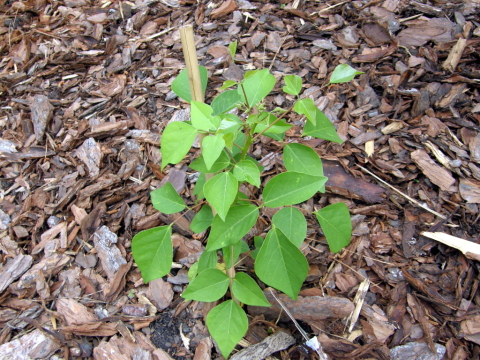


I first heard about Fireman’s Cap at a lecture I attended for under used plants in Houston. This plant is a hummingbird and other bird attractor. They can’t resist those bright red flowers.
Blooms appear late spring, mine started late May this year. It should bloom through out the summer now. Flowers appear first followed by leaves.
It will reach about 8′ tall with a 5′ spread. Fireman’s Cap can go as high as 20′ tall with a 10′ spread. It is fast growing. I stuck this sorry looking one foot tall twig in the ground in March and you can see how large it is the first of June. It is very fast growing, the branches are almost vine like when they first appear, soft and rapidly reaching for anything.
It prefers full sun, but will accept part sun. So they say, however I found mine did much better in part shade than it did in full sun.
Watering needs are average to low, drought tolerant once established. It wasn’t the least bit bothered by the 6 week spell of hot, dry, windy weather we had a few months back.
Be careful where you plant it, the thorns are impressive. You don’t want to have to be pruning it often.
This is a cross between E. crista-galli which is a member of the pea family, and very much like the Fireman’s cap but is not frost hardy and E. herbacea ( Cherokee bean ) which has bright red tube like flowers and is more woody than e. crista-galli.
Seeds are reportedly sterile. It is very cold tender and will drop its leaves and may die back to the ground in colder winters.
Awarded the Merit award by the Cal. Horticultural Society in 1981.
Poisonous do not eat it.
If possible protect from wind and also from hard freezes. Go easy on the fertilizer in the fall to help it prepare for winter but don’t underwater. This one died back to the ground after several hard freezes last winter, but re-appeared mid May 2010.
Propagate by seeds or cuttings.
Cutting propagation:
Remove a new growth that is just beginning to get woody that has at least 3 sets of leaves.
Remove the bottom two sets of leaves.
Dip the stem in rooting hormone powder
Plant in moist soil covering the stem where the two bottom sets of leaves were removed. Using lots of peat moss in your soil helps keep fungus down.
Keep in a moist place and keep soil damp.
Be sure to remove air spaces between stem and soil as these tend to get moldy.
Do not let stem touch bottom of pot. It should have an inch of soil below it.
Note: Survived the great heat and drought of summer 2011, no blooms yet.
You must be logged in to post a comment.